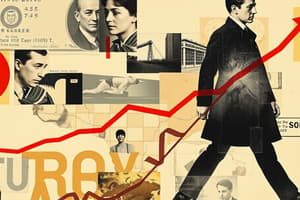Podcast
Questions and Answers
What is frictional unemployment?
What is frictional unemployment?
- Unemployment that occurs when people take time to find a job (correct)
- Unemployment caused by seasonal work
- Unemployment due to a skills mismatch
- Unemployment that occurs because of economic downturns
What causes seasonal unemployment?
What causes seasonal unemployment?
- Temporary job leaves
- Harvest schedules or vacations (correct)
- Market fluctuations
- Skill mismatches
What is structural unemployment?
What is structural unemployment?
- Unemployment caused by personal situation changes
- Unemployment caused by economic cycles
- Unemployment arising from skills mismatch (correct)
- Unemployment due to seasonal work
What happens during cyclical unemployment?
What happens during cyclical unemployment?
What is a census?
What is a census?
What is the unemployment rate?
What is the unemployment rate?
What is full unemployment?
What is full unemployment?
What does it mean to be underemployed?
What does it mean to be underemployed?
What is a discouraged worker?
What is a discouraged worker?
What is inflation?
What is inflation?
What is purchasing power?
What is purchasing power?
What is a price index?
What is a price index?
What is the consumer price index (CPI)?
What is the consumer price index (CPI)?
What is a market basket?
What is a market basket?
What is the inflation rate?
What is the inflation rate?
What is the core inflation rate?
What is the core inflation rate?
What is hyperinflation?
What is hyperinflation?
What is the quantity theory of inflation?
What is the quantity theory of inflation?
What is the demand-pull theory?
What is the demand-pull theory?
What is cost-push inflation?
What is cost-push inflation?
What is the wage-price spiral?
What is the wage-price spiral?
What is fixed income?
What is fixed income?
What is deflation?
What is deflation?
What is the poverty threshold?
What is the poverty threshold?
What is the poverty rate?
What is the poverty rate?
What is income distribution?
What is income distribution?
What are food stamps?
What are food stamps?
What is the Lorenz Curve?
What is the Lorenz Curve?
What is an enterprise zone?
What is an enterprise zone?
What is a block grant?
What is a block grant?
What is workfare?
What is workfare?
Flashcards are hidden until you start studying
Study Notes
Types of Unemployment
- Frictional Unemployment: Occurs when individuals take time to transition between jobs, often seen in a dynamic labor market.
- Seasonal Unemployment: Linked to specific times of the year; influenced by factors like harvest times, holidays, or seasonal industry closures.
- Structural Unemployment: Arises when there is a mismatch between workers' skills and the requirements of available jobs, often due to technological or economic changes.
- Cyclical Unemployment: Fluctuates with the economy; increases during downturns and decreases when economic conditions improve.
Labor and Employment Metrics
- Census: An official count of the population, useful for understanding demographic trends.
- Unemployment Rate: Represents the percentage of the labor force that is unemployed, providing a snapshot of economic health.
- Full Employment: Achieved when there is no cyclical unemployment, indicating an optimal economic condition.
- Underemployment: Refers to individuals working in jobs for which they are overqualified or those who wish to work full-time but are in part-time positions.
- Discouraged Worker: Someone who has stopped seeking employment due to a belief that no jobs are available.
Inflation and Price Measurement
- Inflation: Defined as the general increase in prices across the economy, impacting purchasing power.
- Purchasing Power: Describes the capacity to buy goods and services, directly affected by inflation levels.
- Price Index: A tool for measuring how the average price of a standard group of goods changes over time, crucial for tracking inflation.
- Consumer Price Index (CPI): A specific price index representing the "market basket" of a typical urban consumer, guiding economic policy.
- Market Basket: A representative collection of goods and services used to track price changes.
- Inflation Rate: Indicates the percentage increase in price level over a specific time frame.
- Core Inflation Rate: Excludes volatile food and energy prices to give a clearer picture of long-term inflation trends.
- Hyperinflation: A critical situation where inflation rates soar uncontrollably, often leading to economic collapse.
Theories of Inflation
- Quantity Theory: Suggests that excessive money supply in the economy leads to inflation.
- Demand-Pull Theory: Inflation occurs when the demand for goods and services surpasses supply.
- Cost-Push Theory: Inflation is caused by rising production costs prompting producers to increase prices.
- Wage-Price Spiral: The cycle where increasing wages lead to higher prices, which in turn necessitate further wage increases.
Economic Challenges
- Fixed Income: Income that remains constant despite rising prices, often affecting retirees or those on pensions.
- Deflation: A sustained decrease in the overall price level, potentially leading to economic stagnation.
- Poverty Threshold: The income level deemed necessary to support a household; below this level, families face economic hardship.
- Poverty Rate: The percentage of the population living below the poverty threshold, indicating levels of economic distress.
Economic Assistance Programs
- Income Distribution: Describes how wealth is spread among the population, important for assessing economic equality.
- Food Stamps: Government-provided coupons for purchasing food, aimed at supporting low-income individuals.
- Lorenz Curve: A graphical representation of income distribution, illustrating economic inequality.
- Enterprise Zone: Designated areas exempt from certain taxes and regulations to encourage business development.
- Block Grant: Federal funding distributed to states in lump sums for specific purposes.
- Workfare: Programs that require participants to engage in work in exchange for temporary assistance, promoting job readiness.
Studying That Suits You
Use AI to generate personalized quizzes and flashcards to suit your learning preferences.




